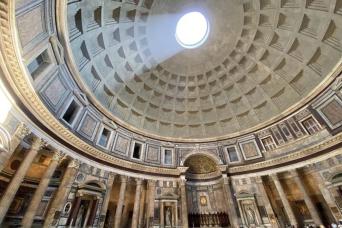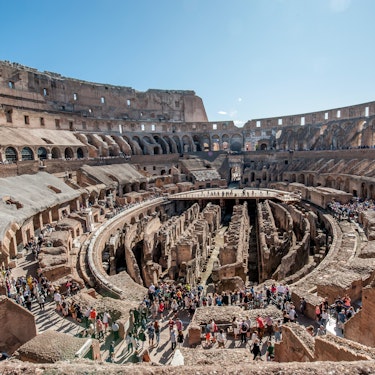More about: The 7 best tours of Rome's Pantheon
It is impossible to talk about Rome without going back to the height of the Roman Empire and the fascinating history that this city possesses in every corner. Rome exudes culture, art and magnificence. The Pantheon is a great example of this. It is visited annually by thousands of tourists eager for knowledge and keen to capture the incredible architecture of the place.
It is undoubtedly a must-see in Rome, and I'm going to tell you why and how you can discover it on the different types of tours available for you to choose from. I'll also tell you how to visit at your own pace and without waiting with skip-the-line tickets.
1. Self-guided tour of the Pantheon with audio guide

This tour is perfect if you don't have much time to visit Rome's most emblematic sites, but still want to experience the cultural richness of the best historical sites first-hand.
All the history behind the Pantheon, its secrets, curiosities and legends. You can also add a guided tour of the most important nearby churches and surrounding squares to the tour.
This audio-guided tour of the Pantheon lasts about 35 minutes, which is the length of the recording, but you can follow at your own pace for as long as you like while exploring the monument.
2. Guided tour of the Pantheon and Santa Maria Sopra Minerva in Rome

If you love exploring historical sites and great monuments that have witnessed the history of modern civilisation, then this tour is ideal for you.
What will you see?
A unique tour of the most religious side of Rome, focusing on the Pantheon of Agrippa and the Basilica of Santa Maria Sopra Minerva.
You will see ancient tombs, learn about the architecture of the period and admire exquisite works of art.
The tour lasts approximately 1.5 hours.
3. Complete tour of the Pantheon in Rome

This tour is perfect for those who want to learn more about the Pantheon in Rome.
What will you learn?
Specialised guides will reveal the greatest mysteries of the monument's construction, the incredible story of the famous brothers Romulus and Remus, the Dominican tribunal against heretics and witches, and many more details.
This tour is designed to be personalised and groups will never exceed 15 people, which is why it is advisable to book in advance.
The tour lasts 1 hour of pure Roman history.
4. Food and wine tour of the Trevi Fountain, the Pantheon and the Campo Dei Fiori market
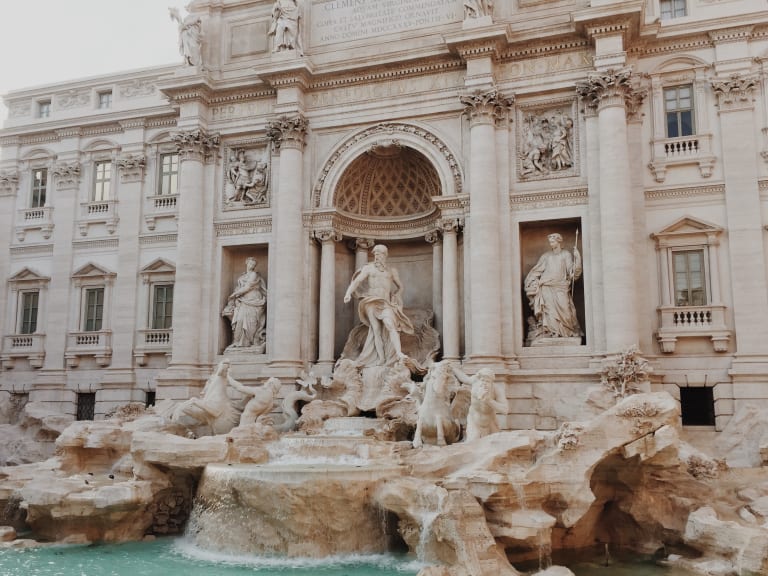
This half-day tour allows you to combine the pleasure of good Italian food, the best wines and the most important historical sites in the Trevi district.
What will you discover?
There's nothing better than tasting a carefully selected assortment of cheeses and prosciutto, accompanied by signature Italian wines, in front of the most iconic sites in the Italian capital, such as the Trevi Fountain, the 2nd-century Pantheon, and Piazza Navona.
The tour includes a visit to the Campo de Fiori farmers' market, where you can buy local delicacies and fresh, artisan products.
This is undoubtedly a different and fun tour that creatively invites you to enjoy the best of the city. I recommend continuing to read this article if you are looking for other activities to enjoy in Rome.
Other gastronomic tours near the Pantheon
The main tourist route that starts at the famous Trevi Fountain and leads directly to the Pantheon in Rome is a must-do on a sunny spring afternoon.
You can lose yourself in the cobbled alleys and discover attractive new places at your own pace.
If your accommodation is close to the area, you can start your day with breakfast at a table on the street in one of the many bars in the area and then set off on your tour with plenty of energy.
The restaurants and food stalls are great for getting to know typical Italian food, such as Neapolitan pizza!
5. Tourist bus through Rome with a stop at the Pantheon of Agrippa

Large open-top sightseeing buses are a classic feature of major cities around the world. And Rome is no exception!
They are perfect if you want to make the most of a long layover, if you only have a few days in Rome, or if you simply enjoy being taken to the best attractions.
The buses have many hop-on hop-off stops, meaning you can get on and off as you please.
You can buy one-day or multi-day tickets depending on your itinerary. I recommend these tourist buses in Rome
6. Walking tour of Rome with the Pantheon and Trevi Fountain
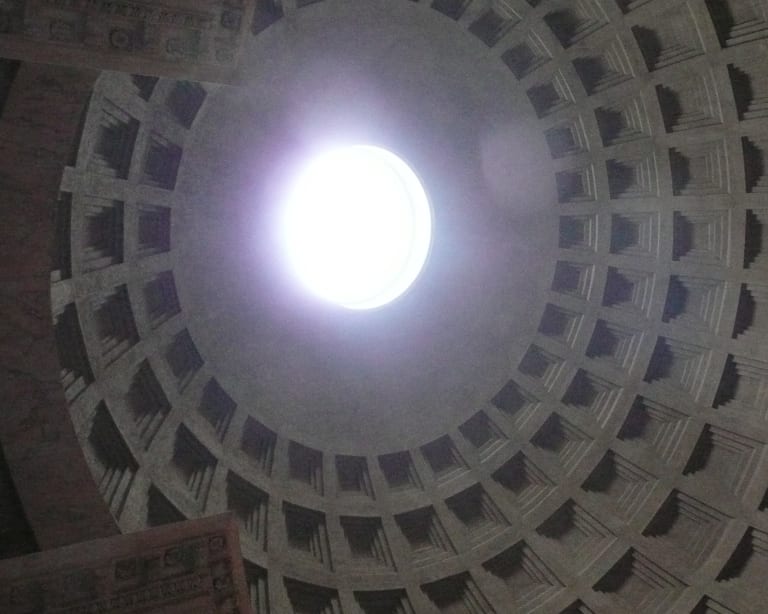
Rome offers a wide range of activities and tours, and every tourist can choose according to their tastes and budget. That's why I'm going to tell you about an excellent and inexpensive walking tour of the city's most emblematic sites.
What will you see?
You will have the opportunity to discover the city's various historical sites in a fun way, such as the Pantheon, the Trevi Fountain, the popular Piazza Navona and Piazza Barberini.
You will be able to photograph and discover the history of the Church of Sant'Ignazio and experience the local culture with a specialised guide who will provide you with all the details.
This tour ends near St. Peter's Square and is ideal if you plan to visit this area in the afternoon.
7. Tour to enjoy the Pantheon in Rome with your family and children

Who said you can't visit museums and historical sites with young children?
What will you learn?
While it is true that children have a shorter attention span than adults and that some details may not be of interest to all ages, there are creative and innovative ways to make the most of your family trip to Rome.
In this case, the tour is customisable and designed so that adults and children alike can have fun with treasure hunts, trivia and interesting facts for all ages.
The guides are specialists in telling anecdotes and providing information to children to capture their interest. In addition, as the tour is only for families, it will be very easy to meet other children along the way.
The best part? You can all enjoy a delicious tasting of authentic Italian gelato together.
The tour lasts approximately 2.5 hours and ends at the previously agreed meeting point. I would like to take this opportunity to recommend this article if you want to know 10 things you can do in Rome with children.
What if I want to visit the Pantheon on my own?
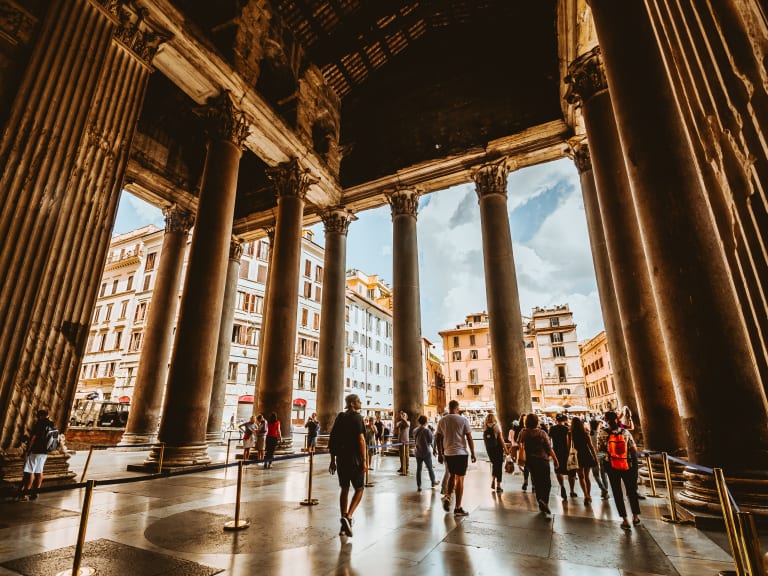
If you prefer to explore the Pantheon in Rome at your own pace and focus on the details that interest you most, you have the option of doing so without joining a guided tour. Visiting on your own is a very flexible way to discover this impressive monument, as you can enter at the time that suits you best, stop at each corner for as long as you like and organise your visit with complete freedom. It is also a perfect alternative if you fancy a more relaxed plan or if you already know part of its history and just want to relive the experience.
To avoid the long queues that often form at the entrance, especially in high season, I recommend booking one of these priority access options in advance:
- Fast-track entry to the Pantheon in Rome: perfect if you just want to ensure skip-the-line access and explore the interior at your leisure.
- Skip-the-line entry with audio guide: includes a digital audio guide in your language so you don't miss out on the most interesting details while visiting the temple at your own pace.
- Rome Explorer Pass: a tourist pass that includes the Pantheon and other attractions in Rome, ideal if you plan to visit several places and save on your tickets.
This way, you can enjoy the spectacular dome and unique atmosphere of the Pantheon without unnecessary waiting and with complete freedom to move around at your leisure.
What you will see on a tour of the Pantheon

From the outside, the Pantheon is imposing and can already be seen from the Place de la Rotonde, a famous square in Rome located in the Trevi district.
Right next to it, you can glimpse an Egyptian obelisk and a very beautiful fountain. But all the beauty of the place is undoubtedly inside. It is magnificent!
The shape of the Pantheon is quite surprising and differs from all the temples in Rome built up to that point.
In fact, it combines three different shapes:
- Its structure is rectangular
- Its entrance is enhanced by a triangular pediment
- Its interior is a cylinder crowned by a dome
A little history and interesting facts about the Pantheon

As I mentioned, the Pantheon was built around 27 BC. It was constructed by Agrippa, a general and politician, under the command of Augustus, the first great Roman emperor.
The monument was built with stones, bricks and mortar.
This temple is dedicated to all gods regardless of their origin, and in particular to Mars and Venus. This is where the meaning of the word "Pantheon" comes from: "pan" means "all" and "theos" means "gods".
Agrippa's Pantheon burned down during the Great Fire of Rome in 80 AD but was later rebuilt between 118 and 125 AD under Emperor Hadrian.
It is a true architectural feat! Its dome has long been the largest in the world, with a diameter of 43 metres.
In fact, Michelangelo himself said that the building has an angelic, rather than human, appearance.
In 609, the Pantheon became a Christian church after being handed over to Pope Boniface IV. It also served as a mausoleum for some Italian kings, such as Victor Emmanuel II, and other great men of the nation, such as the painter Raphael.
Interesting facts about the Roman Pantheon
- The famous oculus was designed from the outset to allow light to enter the Pantheon perpendicularly on both the autumn and spring equinoxes.
- When you look at the ceiling, you will notice five levels, each symbolising the celestial spheres of the ancient planetary system.
- Above the nave of the Pantheon, you will find seven altars dedicated to the astral gods: the Moon, the Sun, Venus, Mars, Mercury, Saturn and Jupiter.
- Both the height and diameter of the Pantheon measure exactly the same: 43.4 metres.
- Although the Pantheon is a great monument of incalculable historical value, it still functions as a church and even hosts certain ceremonies and weddings.
Incredible, isn't it?
Where is the Pantheon?

The Pantheon of Agrippa is located in Piazza Rotonda, in the narrow streets of the Historic Centre district, very close to Piazza Navona.
The Pantheon in Rome is a 7-minute walk from the Trevi Fountain and 15 minutes from the Spanish Steps.
You can get there by metro, taking line A and getting off at the "Barberini" station, or by bus, with several lines that drop you off nearby.
The history of the Pantheon is so rich and full of mysteries that it would be a shame to miss it!

